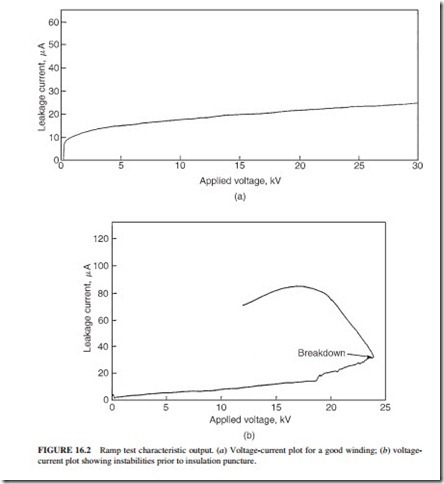DC Hipot Test
A high dc voltage withstand test is performed on a stator or rotor winding to ensure that the ground wall insulation can be stressed to normal operating voltage. The outcome of the test is simply pass or fail. Thus, it is not classified as a diagnostic test. The DC hipot test is done sometimes following maintenance on the winding, to confirm that the winding has not been damaged. It is important to consider the consequences of a hipot failure. Spare parts and outage time should be available before proceeding with this test.
The DC hipot test is based on the principle that weakened insulation will puncture if exposed to a high enough voltage. The test voltage is selected such that damaged insulation will fail during the test and good insulation will survive. Insulation that fails during a hipot test is expected to fail within a short time if placed in service. The distribution of electrical stresses within the insulation during a dc test is different from normal ac operation because the dc electric field is determined by resistances rather than capacitances. Figure 16.1 illustrates how the test is done. The winding is isolated, and a high voltage is connected between the winding and ground. If the stator windings are water-cooled, they must be drained and the system dried thoroughly to avoid electrical tracking of the coolant hoses. The hoses should be removed to ensure they are not damaged by the test. The stator frame and all temperature sensors must be grounded. All accessories such as current and potential trans- formers must be disconnected or shorted. The suggested voltage test for a new winding is 1.7 times the rms ac voltage. A typical routine voltage used during maintenance is 2VL-L kV dc. However, the test voltages used by the manufacturer and during commissioning are sig- nificantly higher than the maintenance test voltage level. The rotor windings do not have a standard test voltage level.
If a hipot test is successful, it confirms that there are no serious cracks in the ground wall and the insulation system. The insulation will most likely withstand normal operating stresses until the next scheduled maintenance test.
High-Voltage Step and Ramp Tests. The variation of current (or insulation resistance) should be monitored as the dc hipot test is performed. If there is a weakness in the ground wall, a sudden nonlinear increase in current (or decrease in insulation resistance) will pre- cede a breakdown as the voltage is increasing. An experienced operator can interrupt the test when the first indication of warning occurs. If the voltage achieved is considered sufficient, the machine can be returned to service until the repairs can be planned. Following identification of a suspect phase, the location of the “weakness” must be found. The variations of voltage with current obtained during the test can be used in future comparisons on the same winding if the same conditions exist.
The winding must be completely isolated (Fig. 16.1). A special “ramp” or conventional high-voltage dc test set is used for this test. The leakage current must be calculated at the end of each voltage step. The test operator must make a judgment based on the increase in leakage current before increasing the voltage further. The test voltage can alternatively be increased slowly with a recorder plotting the variations of leakage current against voltage (Fig. 16.2a and b)..
A weakness in the ground wall can be detected by a sudden increase in leakage current. If the condition of the ground wall is questionable, the machine can be returned to service if the achieved voltage is considered sufficient. Further investigations can be scheduled at a more convenient time.
